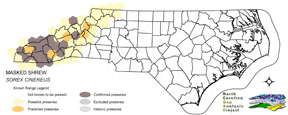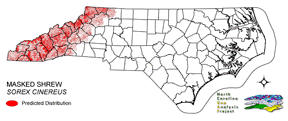
| Taxa: |
| Order: |
| Family: |
| Mammalia |
| Insectivora |
| Soricidae |
| NatureServe Global Rank: |
| NatureServe State (NC) Rank: |
| G5 |
| S4 |
| Federal Status: |
| NC State Status: |
| --- |
| --- |


| Land Unit |
| US Fish & Wildlife Service |
| US Forest Service |
| US National Park Service |
| US Department of Defense |
| NC State Parks |
| NC University System |
| NC Wildlife Res. Com. |
| NC Forest Service |
| NC Div. of Coastal Mgmt. |
| Local Governments |
| Non-Governmental Org. |
| Other Public Lands |
| Private Lands |
| GAP Status 1-2 |
| All Protected Lands |
| Statewide |
| Hectares |
| 0.00 |
| 185,122.71 |
| 139.14 |
| 73,187.64 |
| 3,429.45 |
| 55.80 |
| 4,547.07 |
| 1,069.56 |
| 0.00 |
| 4,829.04 |
| 4,994.64 |
| 112.50 |
| 731,246.49 |
| 104,264.19 |
| 277,129.89 |
| 1,008,734.04 |
| Acres |
| 0.00 |
| 457,448.09 |
| 343.82 |
| 180,850.56 |
| 8,474.35 |
| 137.88 |
| 11,236.05 |
| 3,820.74 |
| 0.00 |
| 11,932.82 |
| 12,342.02 |
| 277.99 |
| 1,806,949.08 |
| 258,820.18 |
| 685,980.54 |
| 2,493,813.41 |
| % of Dist. on |
| Prot. Lands |
| 0.0 % |
| 66.8 % |
| < 0.1 % |
| 26.4 % |
| 1.2 % |
| < 0.1 % |
| 1.6 % |
| 0.4 % |
| 0.0 % |
| 1.7 % |
| 1.7 % |
| < 0.1 % |
| 0.0 % |
| 37.6 % |
| ----- |
| ----- |
| % of Dist. on |
| All Lands |
| 0.0 % |
| 18.4 % |
| < 0.1 % |
| 7.3 % |
| 0.3 % |
| < 0.1 % |
| 0.5 % |
| 0.1 % |
| 0.0 % |
| 0.5 % |
| 0.5 % |
| < 0.1 % |
| 72.5 % |
| 10.3 % |
| ----- |
| ----- |
|
A habitat generalist in cool-temperate climates (Whitaker and Hamilton 1998). The species is known to occur in a variety of habitats from pastures and old fields to dense forest. In North Carolina, the species occurs in the mountains above 900ft (Webster, pers.comm.). Uses a greater variety of habitats than any other Sorex and typically is the most abundant Sorex in moist deciduous, coniferous, or mixed forests (Webster et al. 1985). Will also use grassy fields, sphagnum bogs, swamps, and meadows. NATURE SERVE GLOBAL HABITAT COMMENTS: Occupies most terrestrial habitats excluding areas with very little or no vegetation. Thick leaf litter in damp forests may represent favored habitat, although appears adaptable to major successional disturbances. In Nova Scotia, diet indicated that much foraging was done among wrack on beaches (Stewart et al. 1989). Nest sites are typically in shallow burrows or above ground in logs and stumps. |
| Code | Name | Description | NC Natural Heritage Program Equivalent |
| 267 | Riverbank Shrublands | Riverside shrubs with temporarily flooded hydrologies. Found in the both the Mountains and Piedmont. Containing dominants such as smooth alder and a Carolina or black willows. | Sand and Mud Bar |
| 269 | Floodplain Wet Shrublands | Saturated shrublands of the Piedmont, includes buttonbush, swamp-loosestrife, decodon and alders. | Piedmont/mountain Semipermanent Impoundment |
| 230 | Piedmont Mesic Forest | American Beech - Red Oak - White Oak Forests. | Mesic Mixed Hardwood |
| 384 | Piedmont/Mountain Mixed Bottomland Hardwood Forests | Includes temporarily to seasonally forests dominated by hardwood species. Hardwoods include sweetgum, red maple, sycamore which co-occur in a mosaic of bottomland and levee positions. Includes alluvial hardwood forests in the mountains. Hemlock and white pine may occur as inclusions, but are generally mapped separately. | Piedmont/Mountain Alluvial Forest, Piedmont/Mountain Levee Forest |
| 383 | Piedmont Mixed Successional Forest | Generally loblolly mixed with successional hardwoods. Sweetgum, tulip poplar and red maple are common co-dominants in these successional forests. | No equivalent |
| 51 | Deciduous Cultivated Plantation | Planted deciduous trees. Includes sweetgum and sycamore plantations. | No equivalent |
| 36 | Successional Deciduous Forests | Regenerating deciduous trees with a shrub stature. Commonly dominated by sweetgum, tulip poplars and maples. | No equivalent |
| 205 | Agricultural Pasture/Hay and Natural Herbaceous | Farm fields used for pasture grass or hay production, as well as old fields dominated by native and exotic grasses. | No equivalent |
| 202 | Residential Urban | Includes vegetation interspersed in residential areas. Includes lawns, mixed species woodlots, and horticultural shrubs. Vegetation accounts for between 20 - 70% of the cover. | No equivalent |
| 517 | Hemlock Floodplain Forest | Alluvial forest with hemlock and/or white pine in mountains and western piedmont. Hydrology is generally temporarily to seasonally flooded. | Canada Hemlock Forest |
| 521 | Spruce/Fir Forest | High Elevation Frazer-Fir - Red Spruce, Red Spruce and Red-Spruce-Yellow Birch Forests. Tree densities included here include both woodland to forest density. Highly intermixed with Northern Hardwoods, Grassy Balds, and Shrub Balds. | Red Spruce--Fraser Fir Forest, Fraser Fir Forest |
| 522 | Northern Hardwoods | High Elevation forests including yellow birch, American beech, and yellow buckeye. Includes forests with Hemlock and Yellow Birch. | Northern Hardwoods Forest, Boulderfield Forest |
| 523 | Grassy Bald | High Elevation grassy balds including Pennsylvania sedge, mountain oatgrass, as well as shrubby areas dominated by Alleghany and smooth blackberry. | Grassy Bald |
| 525 | Appalachian Oak Forest | A variety of oak forest types including Black, White, Scarlet Oaks in dry to mesic situations. Includes forests historically co-dominated by American Chestnut. | High Elevation Red Oak Forest, Montane White Oak Forest |
| 526 | Appalachian Cove Forest | Mixed Mesophytic forests of the mountains. Includes tuliptree, basswood, yellow buckeye and surgar maple. This class is mapped to include cove forests dominated or co-dominated by hemlock. | Rich Cove Forest, Acidic Cove Forest |
| 527 | Appalachian Hemlock | Upland hemlock forests of the moutains region. Vary from side slopes to steep slope positions. | Canada Hemlock Forest |
| 533 | Appalachian Swamp Forest | Evergreen and deciduous forests with saturated hydrologies. This class may contain a variety of trees species, including hemlock - red maple, pitch pine, and white pine forests. | Swamp Forest-Bog Complex, Southern Appalachian Bog, Southern Appalachian Fen |
| 534 | Appalachian Wet Shrubland/ Herbaceous | Saturated shrubs and herbaceous vegetation. Often mapped as an inclusion in Appalachian Swamp Forest. | Southern Appalachian Bog, Southern Appalachian Fen |
|
Forsyth, D.J. 1976. A field study of growth and development of nestling masked shrews (Sorex cinereus). J. Mammalogy, 57(4):708-721.
Wrigley, R.F., J.E. DuBois, and H.W. Copland. 1979. Habitat, abundance and distribution of six species of shrewsin Manitoba. J. Mamm. 60:505-520. George, S. B. 1988. Systematics, historical biogeography, and evolution of the genus SOREX. J. Mammalogy 69:443-461. Frey, J. K. 1992. Response of a mammalian faunal element to climatic changes. J. Mamm. 73:43-50. Stewart, D. T., and A. J. Baker. 1992. Genetic differentiation and biogeography of the masked shrew in Atlantic Canada. Can. J. Zool. 70:106-114. Stewart, D. T., A. J. Baker, and S. P. Hindocha. 1993. Genetic differentiation and population structure in SOREX HAYDENI and S. CINEREUS. J. Mamm. 74:21-32. Volobouev, V. T., and C. G. van Zyll de Jong. 1994. Chromosome banding analysis of two shrews of the CINEREUS group:SOREX HAYDENI and SOREX CINEREUS (Insectivora, Soricidae). Can. J. Zool. 72:958-964. Jackson, H. H. T. 1928. A taxonomic review of the American long-tailed shrews (genera SOREX and MICROSOREX). North American Fauna 51:1-238. Churchfield, S. 1992. The Natural History of Shrews. Cornell University Press, Ithaca, New York. 192 pp. Whitaker, J.O. Jr. and W.J. Hamilton, Jr. 1998. Mammals of the eastern United States. Cornell Univ. Press, Ithaca, New York. 583 pp. Stewart, D. T., T. B. Herman, and T. Teferi. 1989. Littoral feeding in a high-density insular population of SOREX CINEREUS. Can. J. Zool. 67:2074-2077. van Zyll de Jong, C. G., and G. L. Kirkland, Jr. 1989. A morphometric analysis of the SOREX CINEREUS group in central and eastern North America. J. Mamm. 70:110-122. Lee, D. S., L. B. Funderburg Jr., and M. K. Clark. 1982. A distributional survey of North Carolina mammals. Occasional Papers of the North Carolina Biological Survey, No. 1982-10. North Carolina State. Mus. Nat. Hist., Raleigh, North Carolina. 72 pp. Gould, E., N.C. Negus, and A. Novick. 1964. Evidence for echolocation in shrews. J. Exp. Zool. 156:19-38. Buckner, C.H. 1966. Populations and ecological relationships of shrews in tamarack bogs of southeastern Manitoba. Jour. Mamm. 47(2):181-194. Banfield, A.W.F. 1974. The mammals of Canada. University of Toronto Press, Toronto. Godin, A.J. 1977. Wild Mammals of New England. Johns Hopkins University Press, Baltimore. 304 pp. Hamilton, William J., Jr., and John O. Whitaker, Jr. 1979. Mammals of the eastern United States. Cornell Univ. Press, Ithaca, New York. 346 pp. Hall, E. R. 1981. The Mammals of North America. Second edition. 2 Volumes. John Wiley and Sons, New York, New York. Schwartz, Charles W., and Elizabeth R. Schwartz. 1981. The wild mammals of Missouri. University of Missouri Press, Columbia. 356 pp. Baker, Rollin H. 1983. Michigan mammals. Michigan State University Press. 642 pp. van Zyll de Jong, C. G. 1983. Handbook of Canadian Mammals. 1. Marsupials and insectivores. Nat. Mus. Canada, Ottawa. 212 pp. Webster, W. D., J. F. Parnell and W. C. Biggs Jr. 1985. Mammals of the Carolinas, Virginia, and Maryland. The University of North Carolina Press, Chapel Hill, NC. Armstrong, D. M. 1987. Rocky Mountain mammals. Revised edition. Colorado Associated Univ. Press, Boulder. x + 223 pp. Bellocq, M. I., J. F. Bendell, and B. l. Cadogan. 1992. Effects of the insecticide BACILLUS THURINGIENSIS on SOREX CINEREUS (masked shrew) populations, diet, and prey selection in a jack pine plantation in northern Ontario. Can. J. Zool. 70:505-510. |
For more information please contact them at:
NC-GAP Analysis Project
Dept. of Zoology, NCSU
Campus Box 7617
Raleigh, NC 27695-7617
(919) 513-2853
www.basic.ncsu.edu/ncgap